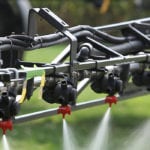The federal government is adopting a new way to manage pesticides, which seems to give a larger role to Environment and Climate Change Canada. On June 20, the government announced the next steps toward a “sustainable approach to pesticides management.” In the past, Health Canada’s Pest Management Regulatory Agency was responsible for pesticide regulation in […] Read more
Tag Archives spraying — page 3

Wind can be an applicator’s friend, says expert
A windy day can provide ‘directional certainty,’ but farmers should avoid spraying in extreme conditions
Wind, wind, wind: it keeps the bugs away, but if you’re a busy farmer with thousands of acres of crop to spray, it can be a royal pain in the neck. Applying expensive and potentially damaging chemicals in windy conditions is not an ideal scenario, says Tom Wolf, a chemical application expert and president of […] Read more
The drones are coming to spray your crops
CORRECTION: This story originally said Don Campbell revived approval from Transport Canada to apply crop protection products with a drone. However, Transport Canada only gave Campbell a special approval to emit fluids from a drone. The Pest Management Regulatory Agency is responsible for the regulation of pest control products in Canada. Roga Drone is […] Read more
Spray technology
Three years deposition experience Robert Brunel has often used a deposition agent in his Apache high clearance sprayer in the past three years. WinField’s InterLock has cost him $1 to $3 per acre, depending on wind, the crop and the product he’s spraying. He said it’s a small price to pay for the benefit he […] Read more

Less time spent filling means more time spent spraying
Cutting sprayer fill times in half would significantly improve farmers’ bottom lines, says a spraying systems engineer. Syngenta researcher Doug Baumann has developed and proofed a mathematical model showing how a producer can fill a 1,200 gallon sprayer in six to eight minutes. He said optimizing fill time is the easiest way for farmers to […] Read more

Ontario growers failing to prevent herbicide drift
RIDGETOWN, Ont. — Herbicide drift can be managed, but the risk may be too great even when the best protocols are in place. “If there are sensitive crops around you, you can make the decision not to apply a chemical,” said Adam Pfeffer, a development representative with Monsanto. “If a plant is sensitive to a […] Read more

Effective spraying starts at the top
Dual tip nozzles may be great for fusarium, but planning and timing are more critical than the technology
PORTAGE LA PRAIRIE, Man. — Only 15 percent of the efficacy of a crop protection package depends on application technology and the spray operation itself. Thinking accounts for the other 85 percent. In fact, technology and application rank a distant third place on the list of three factors that affect the success of a crop […] Read more
Correct nozzle use moves to political radar
Using the right nozzle for the right product at the right water rate could some day become a legal requirement. Tom Wolf of Agrimetrix in Saskatoon says farmers need to consider their application methods as carefully as they do their rates of product. “Legislation is in all of our futures,” he told a farm meeting […] Read more

Sprayer cleanup not to be ignored
Chemicals can build up in the sprayer and cause problems for later operations if they are not properly cleaned out
A spray day doesn’t end when the farmer parks the rig. Producers who use Group 2 products that are formulated as a dry fine ground powder have one more important task when they park the sprayer: cleanup. The issue is compounded if they mix Group 2 dry products with other products that have an oily […] Read moreBetter efficacy with less water
A spray plane equipped with rotary fan atomizer nozzles can reduce drift and put more product on a crop while dramatically reducing water volume. Until recently, aerial applicators with standard nozzles typically put down three to five gallons of water per acre. However, applicators who equip their planes with Davidon Hi-Tek rotary fan atomizer nozzles […] Read more




